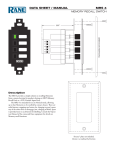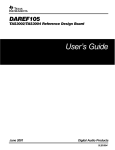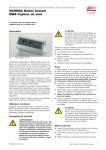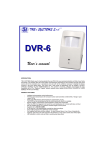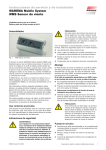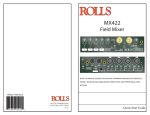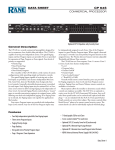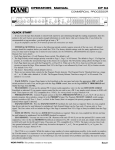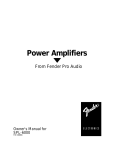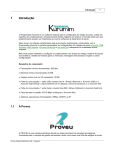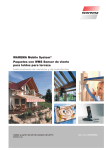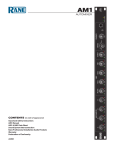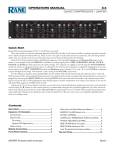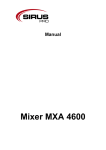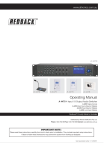Download Manual Compressor DualCom 52
Transcript
Manual Compressor DualCom 52 Table of contents 1. Safety instructions ............................................................................................................................ 3 1.1. 2. FOR SAFE AND EFFICIENT OPERATION ............................................................................ 3 Introduction ....................................................................................................................................... 4 2.1. What compressors and limiters do .......................................................................................... 4 3. Connectors & Cables ....................................................................................................................... 5 4. Control / Connections ....................................................................................................................... 6 5. 6. 4.1. Front ........................................................................................................................................ 6 4.2. Back ......................................................................................................................................... 8 Installation ........................................................................................................................................ 8 5.1. General requirements .............................................................................................................. 8 5.2. AC Power................................................................................................................................. 8 Typical applications .......................................................................................................................... 9 6.1. The unit as a protective device ................................................................................................ 9 6.2. Recording ................................................................................................................................ 9 6.3. De-Essing .............................................................................................................................. 10 6.4. Altering instrument texture..................................................................................................... 10 6.5. Voice-Over Compression (Ducking) ...................................................................................... 10 6.6. Stereo operation .................................................................................................................... 10 7. Troubleshooting.............................................................................................................................. 11 8. Dimensions ..................................................................................................................................... 12 9. Specifications ................................................................................................................................. 12 2 / 13 1. Safety instructions • Read the safety instructions and also this manual carefully. • Keep the manual. • Observe all red flags. • Observe the manual. • To prevent fire or electric shocks, protect the device against rain and humidity • Pull the plug before opening the housing. • To prevent an electric shock you should not remove the cover. • Do not operate the device in the near of water. • Use only a dry cloth for cleaning. 1.1. FOR SAFE AND EFFICIENT OPERATION Be careful with heat and extreme temperature Avoid exposing it to direct rays of the sun or near a heating appliance. Not put it in a temperature bellow 32°F /0°C, or exceeding 104°F /35°C. To avoid placing on un-stable location Select a level and stable location to avoid vibration. Do not use chemicals or volatile liquids for cleaning Use a clean dry cloth to wipe off the dust, or a wet soft cloth for stubborn dirt. Pull the plug before cleaning. If out of work, contact sales agency immediately Any troubles arose, remove the power plug soon, and contact with an engineer for repairing, do not open the cabinet by yourself, it might result a danger of electric shock. Take care with the power cable Never pull the power cable to remove the plug from the receptacle, be sure to hold the plug. When not using the device for an extended period of time, be sure to disconnect the plug from the receptacle. Ventilation It is not allowed cover fans and air in and outlets. 3 / 13 Safety Do not remove the grounding. It is for your safety. If you remove the grounding it can cause electric shocks. Hearing To avoid hearing damages, you should not operate a sound system with high levels. This applies to monitor systems, which are in the near of the ear, headphones or IEMs also. Accessory Please use only the accessory which is set by the manufacturer. Important Damages caused by the disregard of this user manual are not subject to warranty. The dealer will not accept liability for any resulting defects or problems. Make sure the electrical connection is carried out by qualified personnel. All electrical and mechanical connections have to be carried out according to the European safety standards. 2. Introduction Congratulations on your purchase of the compressor/Limiter. Te unit was designed to meet the need for universal peak-sensitive automatic gain control (AGC) devices with exceptional audio performance and rugged durability. The unit has the following key features. • Treshold control • Input/output meter with select switch • Balanced XLR connectors • A single TRS patch point detector loop • Premium components throughout • Quality construction through computerized, automated assembly We are confident that you will be pleased with the high performance, superb sound quality, and reliability that we are known for. 2.1. What compressors and limiters do Limiting All musical programs have constant changes in loudness. It is the job of a limiter to detect when the volume has exceeded a predetermined maximum safe level, and to turn down the volume. When the incoming signal returns to its original level, the limiter should respond by restoring the gain to normal. Thus, when the level is within a specified ‘safe’ range, the limiter has no effect. When an occasional peak occurs, the limiter responds. 4 / 13 Compressing A significant difference in dynamic range is achieved simply by changing the relationship between nominal signal level and threshold, as a result of either increasing the GAIN and/or decreasing the TRESHOLD control. The most interesting effect to be noted, however, is seen by comparing the original input signal with the output signal. The quietest portions of the original signal will be effectively increased in volume while the loudest portions of the original signal will be decreased. In effect, both ends of the dynamic spectrum will be pushed toward the ‘middle’. More than anything else, it is this double-ended effect, which distinguishes compressing from limiting. 3. Connectors & Cables The unit has three different connector types: • ¼‘‘ stereo TRS jacks • 3-Pin XLR • Euroblocks These three connectors facilitate interfacing to most professional audio products. Both inputs and outputs can be used balanced or unbalanced. If you must use unbalanced connectors, the negative lead of the connector should be tied to the ground lead. Using unbalanced connections could result in chassis ground-loop noise. Altering the signal/chassis ground relationship in equipment connected to your unit may eliminate the noise. 5 / 13 4. Control / Connections 4.1. Front 1. Gain The Gain control adjusts incoming signal level to the VCA circuit. It is always active, so switching out the limiter function has no effect on this control. This control should normally be left at ‘0’ to achieve accurate threshold calibration. 2. Treshold The threshold control has a range of -40 to +22dB, allowing applications from low level compression to high level limiting. The threshold control determines the audio level above which gain reduction occurs. When the signal peaks exceed the selected threshold, the LED comes on and gain reduction is occurring, 3. Ratio This control determines the ratio of the change in output level to changes in input level for signals above threshold. The numbers printed around the ration control are calibrated in dB and indicate the increase input (above threshold) required to produce a 1dB increase in output. This can be expressed conveniently as a ratio. If the output remains constant no matter how high the input level, we have an infinite (∞) input/output ratio. It should be remembered that the ratio control has no effect on signals which are below threshold. 4. Attack Time The response of the compressor/limiter to signal levels above threshold is further defined by the attack time control. Attack time is the amount of time that the unit takes to attenuate the output level after threshold has been reached. This unit provides continuously variable attack times from 200 µs und 20 ms. 5. Release Time Release time, is the time required to restore system gain to normal after the input signal has fallen below threshold level. Proper release time will depend on the type of program material being processed and the way in which the limiter is being used. 6. Output Level Output level control is provided to fully cut or restore up to 18dB of system gain. For unity gain, set the control to 0. 6 / 13 7. In/Out Switch This switch enables you to quickly hear the compressor/limiter in or out of the audio chain. When the switch is in the OUT position, all limiting and compression controls and functions are bypassed, with the exception of the gain and output controls, which continue to function. 8. Stereo Tie Switch This switch allows for gain reduction on a stereo signal with no degradation of a stereo image. When pressed in, the stereo tie switch combines each channel’s internal detector outputs so that the channel with the loudest signal will determine the action applied to both channels. Leave this switch for normal operation. 9. Treshold/Gain reduction display As soon as the threshold level is reached, the yellow LED illuminates. Depending on how far the input level rises above threshold, successive red LEDs will illuminate, indicating gain reduction. Gain reduction can best be described as the difference between input level and the resulting change to output level. For signals above threshold, output level will increase only to the extent that the ratio control allows. 10. Input/output meter select While the gain reduction display accurately represents the action of the limiter, comparing input to output level in real time is somewhat more intuitive, and is made simple using the input/output meter select switch. The input meter takes its signal just after the gain control, and will indicate input signal level regardless of output levels or limiter settings. The output meter display takes its signal from the actual output of the unit, so every control that affects the output will also have an effect on output meters. Use in conjunction with the gain reduction meters. Input/output meters prove to be an extremely useful diagnostic tool when working with system dynamics and level control. A unique feature of this compressor/limiter is the incorporation of a double release-time constant. When a conventional compressor/limiter is adjusted for slow release times, transient such as mic ‘pops’ may cause a severe reduction in gain followed by a slow fade up, making the action of the limiter very obvious. With the double fine constant, release from gain reduction after a brief transient is always fast, with a slower release after a sustained overdrive. 7 / 13 4.2. Back 1. Inputs/outputs Your unit Compressor/Limiter is provided with three different connector types: ¼’’ TRS (tipring-sleeve) jacks, XLR connectors and Euroblocks. Inputs are 20kΩ active balanced using 1% metal film resistors, outputs are 132Ω servo-balanced. 2. Detector Loop The Compressor/Limiters have a TRS insert DETECTOR PATCH point which can be used as a ‘ducking’ input, or in conjunction with an equalizer to produce frequency-sensitive limiting. Various uses of the detector patch are discussed under ‘Typical applications’. 3. Power switch 5. Installation Use four screws and washers when rack mounting the unit. For mobile use, the unit should be further secured as appropriate. 5.1. General requirements The unit has specific physical, electrical and signal requirements for proper operation. These requirements will vary depending on your specific application, setup, and the settings on the unit. When setting up and testing your system, please take special care to double check all connections and settings. Please refer to the specifications section of this manual for specific input, output and other figures. 5.2. AC Power Your unit equalizer should be connected to standard 3-wire grounded electrical outlet supplying 100240V, 50-60Hz. To reduce the risk of ground loop hum, connect all audio equipment to the same electrical power source. Removal of the ground pin is both unlawful and dangerous, as a potential shock hazard could result. 8 / 13 6. Typical applications The application of this unit can be divided into two basic categories, limiting and compressing. When used as a protective device it is functioning as a limiter. It may also be used to reduce the dynamic range of a signal, creating a fuller sounding signal without increasing the loudest peaks, in which case it is functioning as a compressor. 6.1. The unit as a protective device The unit provides fast an accurate gain control for the prevention of sound system overload due to unexpected transients. Sustained distortion caused by amplifiers running out of power or occasional, one-shot high level overload (a microphone falling onto a hardwood floor) can damage speakers and other system components. The unit can be installed in several locations in a sound system to specific goals: Signal path location Effect After the mixer and before the crossover and Compression and limiting acts on the entire amplifier(s) signal, preventing crossover and amplifier overload and maximizing the dynamic performance of both. After an active crossover and before the Compression and limiting acts on each segment amplifier(s) of the signal (to which a unit channel is connected) coming from the crossover allowing for different setting in each segment. After a parametric EQ and before the amplifier(s) This setup is typically used to control feedback. By using the parametric EQ as a multipoint notch-filter on the feedback frequencies and the unit to limit those frequencies, an accurate and automatic feedback control can be imposed on a system. 6.2. Recording The unit limiter can be used to prevent input overload (clipping/distortion) in a live recording environment. To prevent distortion while preserving dynamic range set the unit as follows: Gain=0, Threshold=2-3dB below recorder input max, Ratio=10, Attack=2ms, Release=2s, Output=0. Every situation is different, so experimentation before final recording is always a good idea. 9 / 13 6.3. De-Essing A special type of saturation problem often encountered in recording is the sibilant (Ssss) sound of the human voice. The solution is frequency-dependent limiting, which is easily accomplished with the unit. By inserting an equalizer into the detector patch point and boosting the equalizer at high frequencies in the vicinity if the sibilant, the limiter’s detector circuit becomes more sensitive to this particular range of frequencies, and so will limit the bothersome sibilants more than other frequencies. 6.4. Altering instrument texture Compression can be used to help bring out a lead vocal or instrumental solo in a cluttered mix. The compressor is also a great corrective tool when working with singers whose own dynamic control is less than perfect. Experimentation is highly recommended. 6.5. Voice-Over Compression (Ducking) The unit can be used to reduce music to a background level when an announcer is speaking. The detector is connected to respond only to an announcer’s voice. 6.6. Stereo operation On the unit, pressing the stereo tie switch combines the detector outputs so that the loudest channel controls the limiter action of the other channel. This allows true stereo imaging to be preserved regardless of which channel is in gain reduction. 10 / 13 7. Troubleshooting Situation Action No audio output Check AC power- Is the power switch on? Check input and output connections-are they reserved? Are you sure you have an input signal? Controls have no effect Is the Limiter in/out switch in? Perhaps the ratio control is set too low to produce an audible effect or the input level is below threshold. Is the threshold LED lighting up? If not, lower the threshold setting or increase the gain. Do not expect to hear any affect when the input level is below threshold, since the unit is simply a linear amplifier at those levels. When using heavy compression, background Quiet program material is effectively made louder noise is noticeable during quiet section of the while loud peaks are made quieter. When the program program source is thus raised in volume, its noise floor is also raised in volume by a propionate amount. This is not a defect in the compressor/limiter, but an unavoidable side effect of the gain altering process. If the noise becomes a problem, the solutions are to either decrease noise at the program source, or use less compression. Excessive hum or noise Hum is often caused by a ‘ground loop’ between components. Try using the suggested balanced input and output hookup if the other pieces of equipment used in conjunction with the unit have balanced inputs and outputs. Make sure you are sending a nominal 0dBV line level signal to the unit. Unshielded cables, improperly wired connections, and cable with broken strands (shorts, etc.) are the most common problems. Make sure you use good quality cable with connectors soldered firmly on the correct pin. When in doubt, get in touch with your dealer. 11 / 13 8. Dimensions In inches: 9. Specifications Gain +/- 5dB Ratio 2:1 Attack time 200s-20ms Release time 100ms-3s Output -∞ to +18dB Maximum input level +23dB Maximum output level +23dB Input impedance 20kΩ balanced Output impedance 132Ω servo-balanced Frequency response 20Hz-20kHz, +/- 0.2dB Distortion ∞ <0.1% THD, 0dBu, 1kHz <0.15% THD, + 15dBu, 20Hz-20kHz Output hum and noise -96dB Power Requirements 100-240V, 50-60Hz, 30W Measurements 580x4.44x20.3cm Weight 3.6kg Note: 0dBu=0.775Vms 12 / 13 Importer: B & K Braun GmbH Industriestraße 2 D-76307 Karlsbad www.bkbraun.com [email protected] 13 / 13













